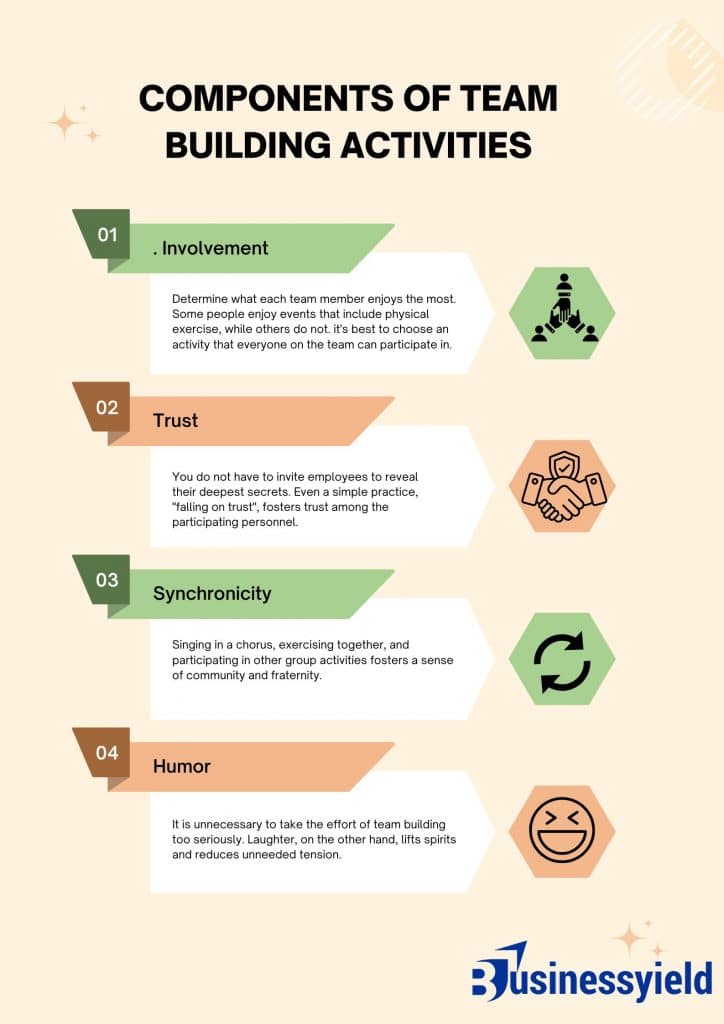If you want to boost morale in the office, host a team-building event. Management can acknowledge the leadership qualities of their staff. Along with helping employees show off skills beyond what is strictly necessary for their employment, team-building activities also help coworkers appreciate the value of working together. There was this one time when I was given this unique challenge—to build something out of nothing but newspaper and tape.
While collaborating with my colleagues, I witnessed the most quiet team members step up to the plate and show off their initiative, creativity, and problem-solving skills. It was an impressive demonstration of how team-building exercises can bring out latent abilities while simultaneously fortifying relationships among coworkers. In light of this, I have compiled a list of team-building exercises that I believe will foster greater involvement and enthusiasm among workers.
Key Points
- Team building activities and exercises improve the effectiveness and relationships among a group of individuals who work together.
- These activities range from trust-building exercises to problem-solving challenges and are intended to improve communication, collaboration, and camaraderie among team members.
- The important components of team building activities include involvement, trust, synchronicity, and humor.
- Examples like icebreaker quizzes, virtual break rooms, virtual scavenger hunts, and professional development workshops are also excellent exercises for improving employee engagement and business culture.
What are Team Building Activities
Improving the camaraderie and output of a group of people who work together is the main goal of team-building activities. Intending to foster better teamwork, communication, and camaraderie, the aforementioned activities include problem-solving challenges and exercises to create trust. Educational institutions, workplaces, and other group settings frequently use team-building exercises to encourage a constructive and effective team mentality.
Being a part of a specialist department or working on a shared project are two of the many reasons people join organizations. However, the ability to work together does not magically appear in people. Collaboration and communication can be challenging when people have different viewpoints and, worse, different value systems.
Cooperation becomes much more difficult when communication is either not there or is interrupted. Instead of working together to achieve goals, they could get defensive and competitive, making progress very difficult, if not impossible. Even when team members have a lot of respect and appreciation for one another, they still need to overcome communication and style barriers to build an effective unit.
Why Is Team Building Activities Important?
Team building is important because it helps us get to know our coworkers outside of the workplace, uncover their personalities, and learn to rely on them. So, team building activities are more than just selecting people who can handle specific responsibilities. It is the skill of building relationships. Based on the research I carried out, I learned that successful collaboration on a shared project necessitates diverse personalities, leadership styles, and drive. Even when work does not require you to connect with coworkers regularly, it’s important to feel that you are a useful member of the team.
Team-building activities are not limited to hired business coaches. Even activities like group trips and board games during breaks can have the desired impact. If you’re having trouble coming up with cooperative entertainment ideas that will appeal to everyone on your team, the following are the important components of an effective team-building event:

#1. Involvement
Try to determine what each team member enjoys the most. Some people enjoy events that include physical exercise, while others do not. That’s why it’s best to choose an activity that everyone on the team can participate in. For example, ask all employees to design a website logo or write congratulations in prose for your company’s anniversary.
#2. Trust
You do not have to invite employees to reveal their deepest secrets. Even a simple practice, “falling on trust” (one person falls on his back and the other helps him up), fosters trust among the participating personnel.
#3. Synchronicity
It is no surprise that religious societies place a high value on communal singing and feasting. Singing in a chorus, exercising together, and participating in other group activities fosters a sense of community and fraternity.
#4. Humor
It is unnecessary to take the effort of team building too seriously. Laughter, on the other hand, lifts spirits and reduces unneeded tension. However, make sure that your jokes are not hurtful, personal, or disrespectful.
Read Also: A Manager’s Guide To Improving Staff Relationships Between Teams
Team Building Activities: Example
Starting the team building process can be challenging, especially if you’re working with a new team that doesn’t know each other well. The activities I listed in this section are designed to help teams and employees get to know each other better and begin to form bonds and trust.
Even if your team has been together for a while, learning more about one another and developing stronger ties benefits both team cohesion and group happiness. These are also excellent exercises for improving employee engagement and business culture, as any corporation is only as strong as its people!
Try these team-building activity examples I listed for business to spark conversation and break the ice, especially if you’re working with a remote team that won’t be in the office together.
#1. Icebreaker Quizzes
Over the years, I have participated in remote team building activities. So, quizzes are an entertaining and safe method to undertake weekly team-building, especially if you have a large number of new workers. Choose an online icebreaker quiz, such as Quizbreaker, that distributes a new set of quizzes to your team every week. Remote teams discover more about one another while having fun.
#2. Virtual Break Room.
To create a virtual break room, you can use Zoom or another platform. Your employees can log in and join during their lunch or break time. This allows colleagues to catch up and become acquainted, much as in a physical office setting. This is a great team-building activity because it encourages employees to exchange intriguing images and films at the water cooler to keep the memories alive.
#3. Beer Making
In this team-building activity, team members become brewers for the day, directly from their homes. The Beer Making Experience leads guests through the entire process, so no prior knowledge is required. Kits are also sent to interested employees.
#4. Virtual Scavenger Hunt.
This team-building activity may be rapidly organized using a Zoom call. It encourages team members to acquire various items from around their houses. The first individual to present all of the essential things wins the search!
During a recent virtual team-building exercise, I went on a treasure hunt; the rules said that our teams had to find and show off things from their own houses. Watching everyone step up their game as the clock crept down was incredible. One group went to great lengths to demonstrate their cooperation and ingenuity by constructing a “museum” out of their possessions. This experience taught me the importance of effective and imaginative teamwork in remote work environments.
#5. Fitness Challenge.
Give your team a timed fitness challenge, such as “chair squats” or a “plank challenge.”. Whoever finishes first wins. This activity is not only enjoyable, but it also gives your staff a good workout. A health company I worked for in the past, organized a fitness challenge. The firm had to deal with problems like disinterest and poor participation rates.
In response to these difficulties, administrators instituted a points-based system that allowed us to get points for engaging in physical fitness activities such as yoga, jogging, and walking. To get people to join, I witnessed the employer give out rewards like gift cards and exercise gear. So, this encouraged a big rise in participation. It also improved my and other staff’s health and morale. This case study shows that fitness challenges can be a great way to get employees interested and healthy.
#6. Professional Development Workshop
Want to foster team camaraderie while allowing each team member to learn and advance their careers? Provide a shared learning experience, whether in your office or through an online workshop or conference. The activity could be targeted at your employees’ jobs, or it could be more general, such as negotiation or leadership skills training.
Professional Checklist for Team Building Activities
#7. What Is My Name
Each participant is given the name of a person, dead or alive, and must wear it on their back, head, or part of their body such that only the other players can see it. List these names on index cards or Post-it notes.
Once team members have been given a name, they mix, treating their coworkers as they would the person stated on that coworker’s card. They can also ask inquiries regarding their own hidden identity until they figure out who they are.
#8. Sneak a Peek.
In this game, teammates divide into groups of at least four and take turns reconstructing objects from memory. Use LEGOs, clay, building bricks, or a comparable collection of construction materials. The leader will construct an object or structure for each group to recreate. A member from each group is then given 10 seconds to “sneak a peek” at the structure (which is hidden), return to their groups, and report what they observed to the rest of the group so they can attempt to recreate it.
Read Also: ICEBREAKER IDEAS: Top Icebreaker Ideas to Motivate & Get the Attention of Team Members
Team Building Activities for Small Groups
Small-group team-building exercises enable people to work together toward a common objective, engage in constructive discourse, and form a cohesive working relationship. Small groups can plan team-building exercises with little equipment; however, major firms and businesses demand a different strategy. The goal of these exercises is to improve collaboration through interactive activities and games. Furthermore, I’ve listed several activities that small groups can participate in to enhance team building.
#1. Office Debates
Office debates with four or more participants are a great opportunity for employees to enhance their public speaking, creativity, and interpersonal skills. To prepare, gather personnel in a presentation-ready space, such as a boardroom. Choose two players to engage in a debate. Depending on your objectives, you can select a work-related or amusing theme. One person argues in favor of the subject, while the other argues against it. Colleagues can then vote on the winner of the argument.
#2. Coat of Arms
Participating in team-building exercises, such as a coat of arms, allows groups to obtain a better knowledge of one another, boosts group creativity, encourages collaboration, and helps with overall team growth. The initial step in the game is to separate into pairs. Each team member then designs their coat of arms and shares it with their spouse. The partner must interpret the coat of arms and present it to the rest of the group.
In the course of a session devoted to the development of teamwork, we participated in a one-of-a-kind activity known as “Coat of Arms.” Using their partners, each member of the team created their coat of arms, which served as a representation of their ideals, capabilities, and goals. Together with my partner, I developed a shield that features symbols that symbolize both our strengths and our joint objectives. The act of presenting it to the group ignited thought-provoking conversations and assisted us in developing a more profound understanding of one another. We were able to develop our bonds as a team as well as our creative abilities through our participation in this exercise.
#3. Pair-Up
Pair-up is a fun group activity in which employees ask questions to figure out what is written on a piece of paper they can’t see. You can play this game at the start of your team-building event to boost enthusiasm, improve communication, and problem-solving skills, and foster creative thinking.
The initial stage is to make individual notes that include several well-known pairs. For example, you may write salt and pepper as one pair. As each participant receives a note that they cannot see, they ask questions to determine which pair they have. The first pair to identify the correct match is the winner.
#4. Cross the circle.
Sharing experiences with people from different backgrounds is an important part of team building. This activity requires each participant to form a circle, with one person in the center. The person in the center poses questions, while the others cross the circle in response. For example, the person in the center of the circle could remark, “Cross the circle if you enjoy playing board games.” At the end of each level, a new team member offers a question to help members get to know one another.
#5. Best and Worst
A good team-building activity might provide conversation starters that encourage participants to share information about themselves. Best and worst require asking each participant a single question about their best and worst experiences. For example, someone might inquire, “What is your favorite recipe?” and “What is your least favorite recipe?” Choose two random questions from the hat and have the group respond.
#6. Quickfire Trivia
Quick-fire trivia is a game that tests participants’ knowledge, quickness, and teamwork. The first stage is to organize team members into groups of two to four people. A facilitator can then read questions from multiple fields. For example, questions may be about history, art, or science. A round lasts two minutes, and the goal is to score the most points possible. Team members receive points for each correct response.
Following the activity, participants can discuss the outcomes and devise methods to improve performance. Members who participate in this activity will have a better understanding of consultation and decision-making in a team setting.
#7. Tell My Story
The Tell My Story game allows team members to participate in creative activities in a small group setting. Members of the group sit or stand in a circle, reading a short story. The group’s first member reads the opening sentence, and the remaining members finish the story one sentence at a time. Taking turns narrating stories from their imaginations results in an utterly unpredictable account that takes the participants’ full attention and inventiveness
Conclusion
Aside from icebreaker questions, virtual break rooms, virtual scavenger hunts, professional development workshops, and office trivia, there are a lot of other team-building activities that I think will work for teams. Just a few of my favorites are on this list. I have seen them used often to boost staff morale and help people get along with their coworkers. Also, once you’ve done a few team-building tasks, you might want to put up a memory wall at work with pictures and stories from the time your team spent learning. By doing so, I think this will make the work environment better and help teams remember how far they’ve come!
What Are the 4 Main Types of Team Building Activities?
It is essential to comprehend the four primary categories of team-building exercises—decision-making, problem-solving, communication-focused, and trust-building—to foster a unified and high-performing group.
What Are the Stages of Team Building?
Common names for these phases include forming, storming, norming, performing, and adjourning. As the team matures and gains capability, relationships form, and the leadership approach shifts to one that is more collaborative or shared, according to Tuckman’s model.
Why Do We Need Teambuilding?
So many critical functions of a team, including morale, productivity, communication, and collaboration, are dependent on team development. Above all, team building plays a pivotal role in fostering and sustaining team confidence, which is intrinsically linked to productivity, employee retention, and successful decision-making.
What Is the Difference Between a Team and a Group?
A team is a collection of individuals who work together toward a common objective, whereas a group consists of individuals who coordinate their efforts. Promoting healthy working dynamics requires an understanding of the distinctions between the two to enhance professional relationships.
How Do You Announce Team Building Activities?
Consider the following subject lines:
- Attend our upcoming, thrilling event.
- You are cordially invited to our team-building activity.
- Are you aware? Upcoming special team exercise!
- The countdown has begun. Attend the team event with us!
- Consult the calendar. A team event is approaching.






